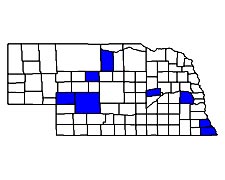
| Cicindela lepida Dejean |
| Adult Length: 9.5 to 12 mm |
| Appearance: Adults of this species are very pale in appearance. The ground color is bronze, but not readily noticed because of the expanded maculations. The maculations consist of the normal lunules, but all are greatly expanded so as to cover the majority of each elytron. The head and pronotum are usually metallic pinkish or greenish and heavily cloth with whitish setae. The appendages and ventral surfaces are pale unlike in most other Cicindela species and are heavily clothed with whitish setae. |
| Similar Species: It is unlikely that adults of this species would be confused with those of any other. Though they might appear somewhat similar to C. limbata, the maculation pattern is distinct, and the pale appendages and ventral surfaces of C. lepida are distinctive. |
| Biology: This species occurs in areas of loose dry sand. Preferred habitats include dunes and blowouts, but it may colonize old sand pits. When alarmed, adults may be reluctant to fly, relying on cryptic coloration to evade detection. If they do fly they somewhat resemble a white fluffy seed. They normally do not fly far, usually less than 10 meters. They are; however, highly attracted to lights at night and may turn up at lights several kilometers from the nearest suitable habitat, suggesting that they are capable of flying long distances. |
| Adult Life History: Adults emerge from the pupa in June and early July. Peak numbers occur from early July to early August, and adults are scarce by September. The adults are apparently quite active at night and during the evening hours, but are also encountered during the day. Adults may be attracted to lights at night. It is a summer species. |
| Larval Life History: Eggs are laid mostly in July. Most larvae reach the second instar by fall before overwintering. The third instar is reached the following summer before a second overwintering period. Pupation occurs the following year, mostly in May and June. Larval burrows occur in loose dry sand and are about 1.7 meters deep on average. |
| Biogeography: This species has only been collected in eleven counties in Nebraska. Though it may be overlooked because of its cryptic coloration, short adult seasonality, and strict habitat needs, it has suffered severe declines across much of North America. In North America it ranges from the Chesepeake Bay area into New England, west through the southern Great Lakes to Illinois and Wisconsin, and to the west and south to southern Manitoba and Saskatchewan, western Nebraska, eastern Colorado, northern Texas, Mississippi, New Mexico, Arizona, and Utah. It is disappearing from many parts of its distribution as a result of natural succession and disturbance including habitat such as ATV’s. |

